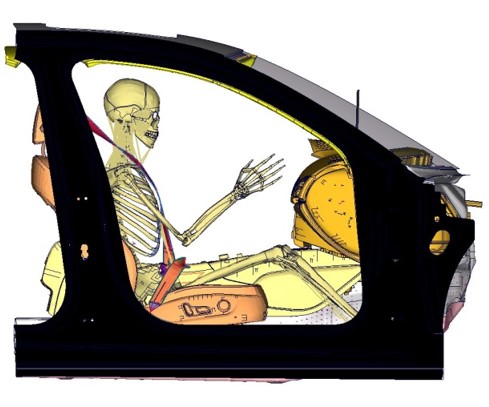Computational Injury Mechanics
de / en
Dipl.-Ing. Felicitas Lanzl
Mechanical Engineering TU München
Computational Methods
Dr. rer. biol. hum. Dipl.-Ing. Raúl Aranda Marco
Mechanical Engineering University of Zaragoza
Personal Protective Equipment
Laura Rahm, M.Sc.
Computational Science and Engineering Universität Ulm
Occupant/Vulnerable Road User Modelling
Johanna Kerschreiter, M.Sc., cand. med.
Mechanical Engineering TU München
Current Vacancies:
- JobAdvertisement_TUC_IRCs.pdf (167 KB)
Contact projects:
Prof. Dr. rer. biol. hum. Dipl.-Ing. Steffen Peldschus
Contact recruitment/students:
biomechanik.rm@med.uni-muenchen.de
Recent publications
- Raúl Aranda-Marco, Steffen Peldschus. Virtual Assessment of a Representative Torso Airbag under the Fall from Height Impact Conditions, Safety (2023), DOI:10.3390/safety9030053
- Felicitas Lanzl, Fabian Duddeck, Saskia Willuweit, Steffen Peldschus. Experimental characterisation of porcine subcutaneous adipose tissue under blunt impact up to irreversible deformation, International Journal of Legal Medicine (2021), DOI: 10.1007/s00414-021-02755-0
- Dustin Draper, Alok Shah, Steffen Peldschus, Brian D. Stemper. Initial Validation of a Human Body Model Lumbar Spine using Dynamic Compression, IRCOBI 2020, IRC-20-28
- Raúl Aranda-Marco, Wei Wei, Thierry Serre, Pablo Sánchez, Enric Soriano, Steffen Peldschus. Limitations of the Standard Test Procedure for Assessing the Protection of Motorcyclist Airbag Jackets in a Realistic Impact Scenario, IRCOBI 2020, IRC-20-44
- María González‐García, Jens Weber, Takahiko Sugiyama, Steffen Peldschus, Baptiste Sandoz. Closing the Gap between Sled and In-Vehicle Volunteer Head-Neck Kinematics under Moderate Lateral Accelerations, IRCOBI 2020, IRC-20-55
- Lucas Low, Robert Salzar, Dustin Draper, Steffen Peldschus, Nicolas Newell, Spyros Masouros. A Quick Running Model of the Spine for High Rae Axial Loading, IRCOBI 2020, IRC-20-96
- G. Bacquaert, C. Bach, D. Draper, S. Peldschus & F. Duddeck (2020) Positioning human body models for crashworthiness using model order reduction, Computer Methods in Biomechanics and Biomedical Engineering, DOI: 10.1080/10255842.2020.1763321
- O Zander, M Wisch, J Ott, M Burleigh, S Peldschus, D Hynd. Development and Evaluation of an Upper Body Mass (UBM) for the Flexible Pedestrian Legform Impactor (FlexPLI) and for Incorporation within Improved Test and Assessment Procedures – Results from SENIORS, IRCOBI, Florence, 2019, IRC-19-54
- Sebastian Büchner, Mirko Junge, Giacomo Marini, Franz Fürst, Sylvia Schick & Steffen Peldschus (2019) A priori prediction of the probability of survival in vehicle crashes using anthropomorphic test devices and human body models, Traffic Injury Prevention, DOI: 10.1080/15389588.2019.1619079
- Dustin Draper, Andreas Huf, Phillip Wernicke, Steffen Peldschus, The Influence of reclined seating positions on lumbar kinematics and loading in frontal impact scenarios, Proceedings of IRCOBI
- Philipp Steinert, Therese Fuchs, Raul Aranda, Dustin Draper, Bengt Pipkorn, Steffen Peldschus, Preliminary Biofidelity Evaluation of GHBMC Pedestrian in Full Scale Impact against Generic Vehicle Buck; IRCOBI, Athens, 2018, IRC-18-63
- Dustin Draper, Nicolas Newell, Phillipp Wernicke, Therese Fuchs, Spyros D. Masouros, Steffen Peldschus, A Comparison of the Compressive Behaviour of Lumbar Intervertebral Discs in Five Human Body Finite Element Models, IRCOBI, Athens, 2018, IRC-18-36
Thesis in Computational Injury Mechanics
Virtual representations of the human body based on the Finite-Element Method (FEM) have considerably gained in importance as complementary tools to conventional dummy models in passive safety divisions of automotive companies. Not only today’s highly advanced safety systems, like new belt configurations or adaptive airbag systems, are further optimized using so-called Finite-Element Human Body Models (FE HBM). The models are also expected to become the method of choice when designing new interior concepts expected in highly automated vehicles (HAV), such as reclined seating positions, or when analysis future crash scenarios. A detailed analysis and prediction of injury mechanics prior and during a crash for a broad variety of impact scenarios is possible with such models, far beyond the capabilities of a conventional crash test dummy.


© Toyota Motor Corporation and Toyota Central R&D Labs © LMU


Segura, Fürst, Langner, Peldschus, ESAR 2012
Master Theses or other student’s work within the Group Computational Injury Mechanics of the Biomechanics and Accident Analysis (LMU) unit addressing the application of FE HBMs in automotive applications are regularly offered to students who already gained experiences with FEM (explicit) and who ideally already know or are highly motivated to learn about (injury) biomechanics.

